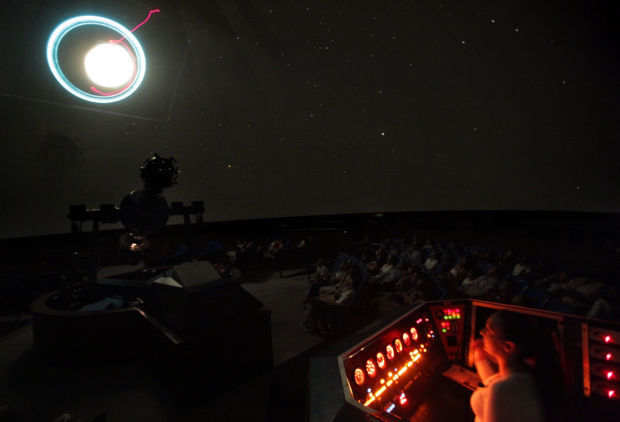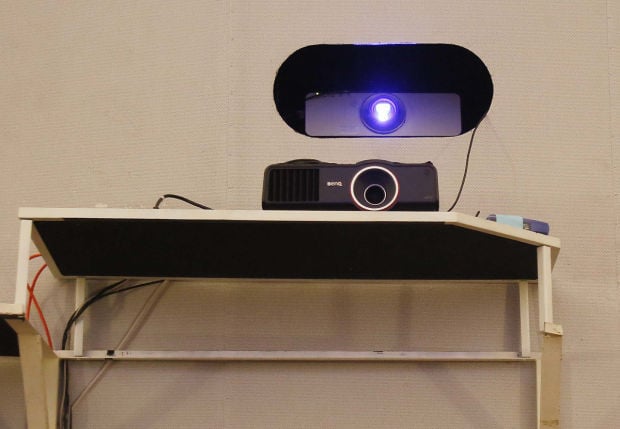Hector Vector Star Projector blew a gasket when forced into retirement by Flandrau Science Center’s groovy new Full Dome.
Hector, a veteran performer and star of the show back when the joint was called Flandrau Planetarium, was first forced into retirement in 2009, when Flandrau closed due to budget difficulties at the University of Arizona.
He was pressed back into service when the UA College of Science reopened Flandrau Science Center the following year.
Hector limped along in his analog geezerdom through more star shows and astronomy classes until Full Dome showed up this year in all its digital glory.
The College of Science raised $700,000 to buy the “Colorspace” planetarium system from the SCISS company in Sweden.
UA facilities engineers repaired the blown gasket on one of Hector’s hydraulic legs so that he could rise up from the center of the room and take a few bows last week as the university introduced the new machine to students and media, and readied it for public shows beginning Friday.
Full Dome has none of Hector’s physical charm. Hector is big, robotic and retro sci-fi.
Full Dome, well ... it’s a couple of digital projectors connected to a laptop.
But it puts on a good show with 4K resolution (four times the resolution of a high-end HDTV), a full 360-degree projection and 1,000 watts of power in its stereo system.
Astronomy professor Tom Fleming was positively ebullient (but then, he always is) in his first “Stars” class last Tuesday.
“What other class does this?” he asked as he “flew” his audience from Tucson to the North Pole to demonstrate how the night sky changes with latitude.
“I love the stars,” said Melanie Gin, a sophomore English major. She was ready to sign up for the astronomy course but was even more enthusiastic when she heard the classroom had new capabilities.
Full Dome can take you past the visible stars and into distant galaxies, using the Digital Universe software created by the Museum of Natural History’s Hayden Planetarium.
Scott Hansen, a general-studies major with an emphasis in science, has already taken several general-education classes in astronomy, and he said this should be the best so far after his introduction to Fleming and Full Dome.
The Stars class “was still really interesting” when she took it last year with Fleming and old Hector, said Gabriela Diaz, who is back this year as one of Fleming’s preceptors.
“But it was hard to see the stars. This makes it easier to visualize.”
Elliott Cheu, assistant dean of the College of Science, said he hopes to wow a variety of audiences with the upgrade at Flandrau.
“It’s a really cool tool to meet all of the objectives — public outreach, teaching and research.”
The college isn’t done with its fundraising for Flandrau, he said. It wants to install new seating and invest in additional hardware and software for Full Dome. One of his goals is to produce shows locally that will highlight all of the sciences at the UA. “I would like to do a Sky Islands show and one on the Sea of Cortez,” he said.
For now, Flandrau — at 1601 E. University Blvd. on campus — will rotate five different shows about various aspects of the cosmos Tuesdays through Sundays at various times. Details are at Flandrau.org
The new audio system should enhance the 9 p.m. Saturday show — planetarium standby “Dark Side of the Moon.”
The lasers have not been upgraded, but then, neither have Pink Floyd’s songs.









